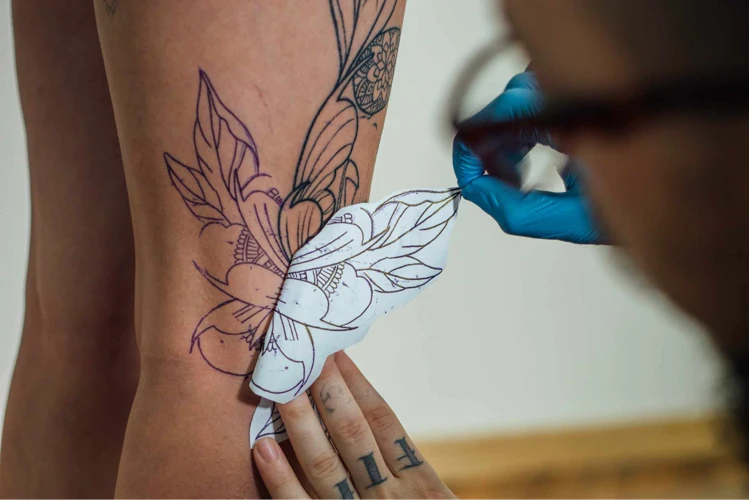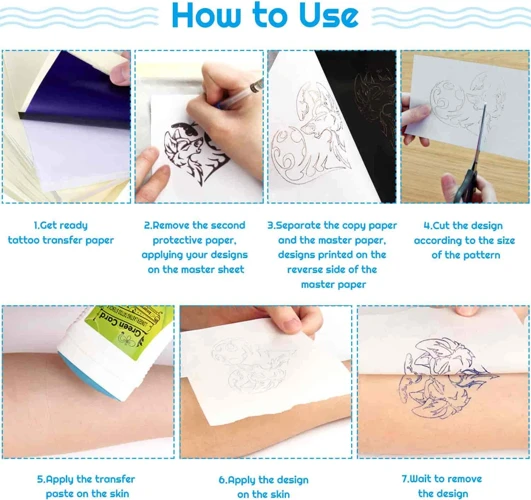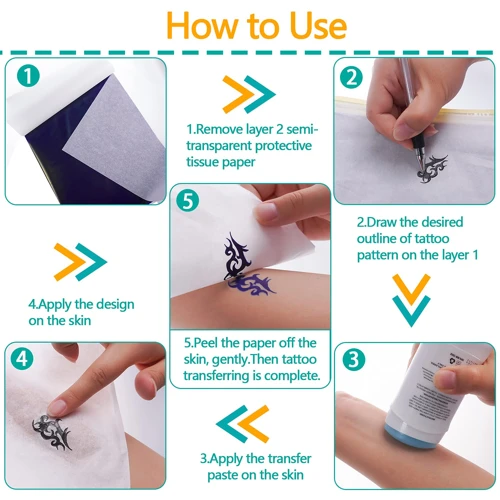Are you looking for an easy way to transfer a tattoo stencil onto your skin? If so, you have come to the right place! In this article, you will learn “What Can I Use to Transfer Tattoo Stencil to Skin?” You will discover a variety of different materials and methods you can use to make the process of transferring your tattoo stencil to skin much easier. Read on to find out more!
Contents
Benefits of Transferring Tattoo Stencil to Skin

- Accurate Design – Transferring a tattoo stencil to skin can help ensure that the design is accurate and precise. This can be especially beneficial if the tattoo artist is dealing with intricate details or small lines.
- Time-Saving – When transferring a tattoo stencil to skin, the process can be done quickly and efficiently. This can help save time and ensure that the tattoo artist is able to complete the design in a timely manner.
- Ease of Use – Transferring a tattoo stencil to skin is fairly simple and straightforward. This can make it easier for the tattoo artist to create a beautiful design without having to worry about the process being complicated or time-consuming.
- Cost-Effective – When transferring a tattoo stencil to skin, it can be done without the need for transfer paper or other materials. This can help save money and make it easier for the tattoo artist to keep their costs low.
Transferring a tattoo stencil to skin is an effective way to create a beautiful and accurate design. It can help save time and money and make it easier for the tattoo artist to create a stunning piece. There are various ways to transfer a tattoo stencil to skin, including using stencil paper or freehanding the design directly onto the skin. For those looking to transfer a tattoo to skin without transfer paper, there are a few effective methods to try.
Different Ways of Transferring Tattoo Stencil to Skin

Traditional Methods
The traditional method for transferring a tattoo stencil to skin involves the use of transfer paper. This paper has a special coating that helps the image transfer onto the skin with minimal effort. The paper is usually available in a variety of sizes and is easy to use. To transfer the tattoo stencil to skin, the artist will place the paper onto the area of skin where the tattoo will be located, and trace the stencil. The image will transfer onto the skin, and the artist can then begin the tattoo process.
Alternatives to Transfer Paper
For those who do not have access to transfer paper, there are several alternatives that can be used to transfer a tattoo stencil to skin. These alternatives include:
- Carbon Paper – Carbon paper is a great alternative to transfer paper, as it is readily available and easy to use. To transfer a tattoo stencil with carbon paper, the artist will need to place the carbon paper onto the area of skin where the tattoo will be located, and trace the stencil. The image will transfer onto the skin, and the artist can then begin the tattoo process.
- Soap and Water – This is another great alternative to transfer paper, as it is both simple and inexpensive. To transfer a tattoo stencil with soap and water, the artist will need to mix soap and water together and then use it to trace the stencil onto the area of skin where the tattoo will be located. The image will transfer onto the skin, and the artist can then begin the tattoo process.
- Pencil and Water – This is another great alternative for those looking for a way to transfer tattoo stencil to skin without transfer paper. To transfer a tattoo stencil with pencil and water, the artist will need to use a pencil to trace the stencil onto the area of skin where the tattoo will be located, and then use a damp cloth to transfer the image onto the skin. The artist can then begin the tattoo process.
Using one of these alternatives to transfer a tattoo stencil to skin is a great way to achieve the desired result without having to purchase transfer paper. With the right tools and a little bit of patience, it is possible to create a beautiful tattoo with ease.
Tips for Transferring Tattoo Stencil to Skin

1. Pre-Ink the Stencil: Before transferring the tattoo stencil to the skin, pre-ink the stencil by using a small amount of ink to trace over the design. This will help the stencil adhere better to the skin and make the lines sharper and more defined.
2. Clean the Skin: Before transferring the stencil to the skin, make sure to clean the area with a gentle soap and warm water. This will help ensure the stencil adheres properly and will also help reduce the risk of infection.
3. Use Transfer Paper: Transfer paper is specifically designed for transferring tattoo stencils to the skin. To use transfer paper, place the stencil face down on the transfer paper and trace over the design with a pen or marker. Then, press the transfer paper onto the skin and gently rub it until the stencil is transferred.
4. Use Carbon Paper: Carbon paper is a cheap and easy way to transfer a tattoo stencil to the skin. Place the stencil face down on the carbon paper and trace over the design with a pen or marker. Then, press the carbon paper onto the skin and trace over the design with a pen or marker. The carbon paper will transfer the design onto the skin.
5. Use Stencil Transfer Cream or Gel: Stencil transfer cream or gel is specifically designed to transfer tattoo stencils to the skin. To use the cream or gel, apply a thin layer to the skin and place the stencil on top. Then, press down on the stencil and wait for a few minutes before removing it. The stencil will be transferred onto the skin.
Safety Considerations for Transferring Tattoo Stencil to Skin

- Sterilize the equipment: Disinfect any surfaces, tools, and equipment that will come into contact with the skin. This includes the stenciling machine, stencils, and transfer paper.
- Use clean and sterilized needles: Make sure that the needles you use are clean and sterile and that they are changed between each tattoo. This helps to prevent the spread of bacteria or infection.
- Wear protective gear: Wear gloves and a face mask. This helps to protect you from any chemicals or materials that may come in contact with your skin.
- Use a transfer paper: Use a transfer paper to ensure that the stencil is accurately and precisely transferred. This will help to minimize the risk of infection or irritation.
- Avoid using harsh chemicals: Do not use any harsh chemicals on the skin during the stenciling process. This can cause irritation or damage to the skin.
- Clean the area: Make sure to clean the area where the tattoo will be applied with an antiseptic solution. This helps to eliminate any bacteria or germs that could cause infection.
- Follow the artist’s instructions: Make sure to follow the instructions of the tattoo artist to ensure that the process is done correctly and safely.
Potential Issues with Transferring Tattoo Stencil to Skin
- Inaccurate Stencil Placement: If the stencil is not placed correctly, the tattoo design can be distorted and off-center.
- Difficult to Remove: Removing the stencil can be difficult, as it often requires time and effort to scrub off the adhesive.
- Fading: Inks used to transfer the stencils can fade quickly and may need to be reapplied multiple times to keep the stencil in place.
- Infection: Improperly handled stencils can spread bacteria and cause infection.
- Irritation: Stencils can irritate the skin and cause redness and itching.
Frequently Asked Questions
What is the Best Way to Transfer a Tattoo Stencil to the Skin?
The best way to transfer a tattoo stencil to the skin is by using a stencil transfer paper. This paper is specifically designed to easily and safely transfer a tattoo stencil to the skin, and is available in various sizes to suit the size of the tattoo. It is recommended to use a special transfer paper over a regular paper, as it won’t smudge and makes sure a precise transfer. The transfer paper should be placed over the tattoo stencil and then firmly pressed onto the skin with a stiff object such as a spoon. The stencil will then be transferred to the skin and can be used as a guide for the tattoo artist.
How Long Does the Stencil Transfer Process Take?
The stencil transfer process typically takes just a few minutes. It involves applying a transfer paper to the skin with a stencil, and then pressing a damp cloth on top of the paper to transfer the image onto the skin. Once this process is complete, the stencil can be removed and the tattoo is ready to be applied.
How do I keep my stencil from smudging during the transfer process?
To ensure a smooth stencil transfer, use a stencil transfer paper that is specifically designed for this purpose. When transferring the stencil, press firmly and evenly to avoid any smudging. After transferring, wait for a few minutes before removing the paper to allow the stencil to fully adhere. Additionally, you can use a stencil transfer gel to help the stencil stay put.
Are there any special precautions I should take when transferring a tattoo stencil to the skin?
It is important to take certain precautions when transferring a tattoo stencil to the skin. The skin should be thoroughly cleaned and disinfected prior to application. Make sure to use a non-toxic, sterile transfer paper for the stencil and avoid reusing it. Additionally, avoid applying too much pressure when transferring the stencil, as this can result in smudges or irregularities. Finally, be sure to check the stencil for accuracy before beginning the tattoo.
Can I use the same stencil multiple times for different tattoos?
Yes, you can. Using the same stencil multiple times is an efficient way to transfer the same design to different parts of the body, or even to different people. Here are the steps to do it:
- Choose your desired tattoo design and print it out on a stencil paper.
- Place the stencil paper on the skin and secure it with a stencil transfer gel.
- Once the stencil is secure, trace the design with a pen.
- After tracing, remove the stencil from the skin.
- Repeat the process for each tattoo you desire.
It is important to note that you should use a new piece of stencil paper each time you transfer the design. This will ensure that the stencil does not become too worn out, leading to a distorted design.
Conclusion
Tattoo stencils can be transferred to skin using a variety of methods, with the most common ones being thermal transfer paper, stencil transfer cream, and stencil transfer pens. Depending on the complexity of the design, some methods are more suitable than others. Moreover, the choice of transfer method should depend on the skill level of the tattoo artist and expertise required to replicate the design accurately.